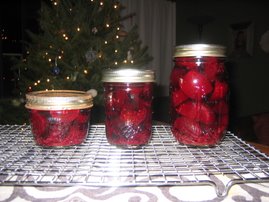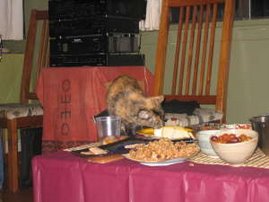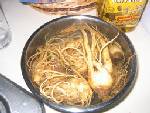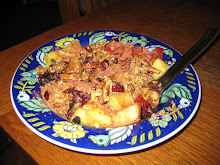 Persephone is a mythological figure from ancient Greece who was seduced by her uncle, Hades, god of the underworld. Hades lured Persephone to him with a pomegranate. Zeus punished Persephone by banishing her to the underworld for six months a year--one month for each of the six seeds she ate. The remainder of the year she could spend with her mother, Demeter, the greek Mother Earth. For six months of every year, Demeter mourns the loss of her daughter; she celebrates during the other six. This is how the ancient Greeks explain the changing of the seasons, and this is how The Love Bite, my favorite recipe treasure trove, describes the origin of the dish Persephone's Ruin. (See http://thelovebite.com/recipes/the_main_event/persephones_ruin)
Persephone is a mythological figure from ancient Greece who was seduced by her uncle, Hades, god of the underworld. Hades lured Persephone to him with a pomegranate. Zeus punished Persephone by banishing her to the underworld for six months a year--one month for each of the six seeds she ate. The remainder of the year she could spend with her mother, Demeter, the greek Mother Earth. For six months of every year, Demeter mourns the loss of her daughter; she celebrates during the other six. This is how the ancient Greeks explain the changing of the seasons, and this is how The Love Bite, my favorite recipe treasure trove, describes the origin of the dish Persephone's Ruin. (See http://thelovebite.com/recipes/the_main_event/persephones_ruin) I've been dying to try this recipe, so when friends invited us up to their country place in Pennsylvania for Easter, I knew that this is what I wanted to make. I had to adapt the recipe a bit because I couldn't get the right kind of lamb, nor could I get pomegranates. While this recipe reads and tastes like a Spring recipe, it clearly isn't because pomegranates are not in season in April in this area.
For all of the many dishes I've served to all of my friends, I received the most--and the best--compliments for this one. One of our friends who is a chef himself said that this was the best dish he'd ever tasted, and that it reminded him of something his mother once said about another dish: "Every bite says I love you." Well worth the effort for that kind of praise.
Persephone's Ruin
Spring in New York version
1 package of phyllo dough
1 stick of butter
1 lb ground lamb
1 onion
3 cloves of garlic
smidgen of cumin powder
8 oz goat cheese
1 egg yolk
salt and pepper
6 golden beets
pomegranite molasses
olive oil
The day before, place the beets in aluminum foil, drizzle them with olive oil, and season with a little bit of salt and pepper. Bake them at 350 until tender (about 1 hour). Dice the onion and garlic, and saute in olive oil until translucent. Add the ground lamb, season with a bit of salt and pepper and some ground cumin. Cook until just beginning to brown. Place in a bowl with 3 tbsp pomegranate molasses, cover, and put in the fridge.
When the beets are done roasting (you can tell when they are tender enough to poke through with a fork), take them out, let them cool down a bit until you can handle them, and then, running them under cold water, peel the skins off with your hands. Cut the beets into rounds and refrigerate.
The next day, brush a sheet of phyllo pastry with melted butter, place another sheet on top, and repeat until you have 8 sheets stacked. Place the phyllo stack in a buttered loaf pan and press the pastry to sides of pan. Brush the inside with butter. Pre-heat the oven to 400. Mix 8 ounces of goat cheese with 1 egg yolk and beat lightly. Reserve 1/4 of the goat cheese, and spread the rest onto the phyllo pastry. Line the goat cheese with the golden beet rounds, then place the ground lamb on top. Spoon the reserved goat cheese in small clumps on top of the lamb and fold the phyllo dough over the entire mixture. Brush with butter and pop it in the oven. It should cook for about an hour, maybe more, until the phyllo dough has turned a golden brown color.
I served this as a good-sized appetizer to 10 people; it could probably be a nice dinner for 4-6 people, depending on your sides and how much you eat. I also served it with a Cucumber Mint Yogurt Sauce on the side, as the original recipe called for chopped mint on top of an open phyllo dish.
Cucumber Mint Yogurt Sauce
1 cup lowfat plain yogurt (labne or Greek yogurt would be the best)
2 chopped scallions
2 finely minced garlic cloves
1 peeled and finely grated cucumber
salt & pepper
Mix all of the ingredients together and season to taste with salt and pepper.

















No comments:
Post a Comment